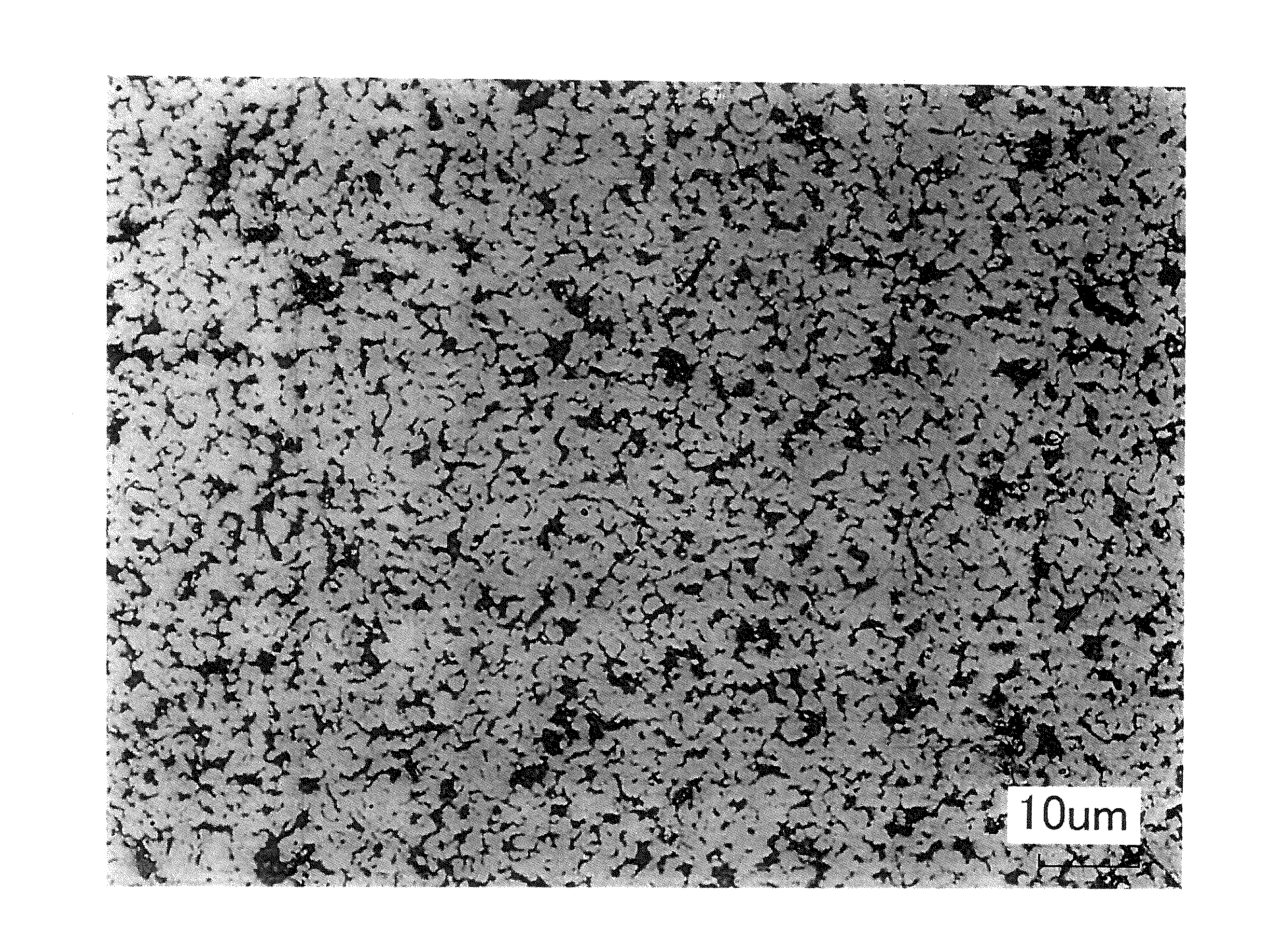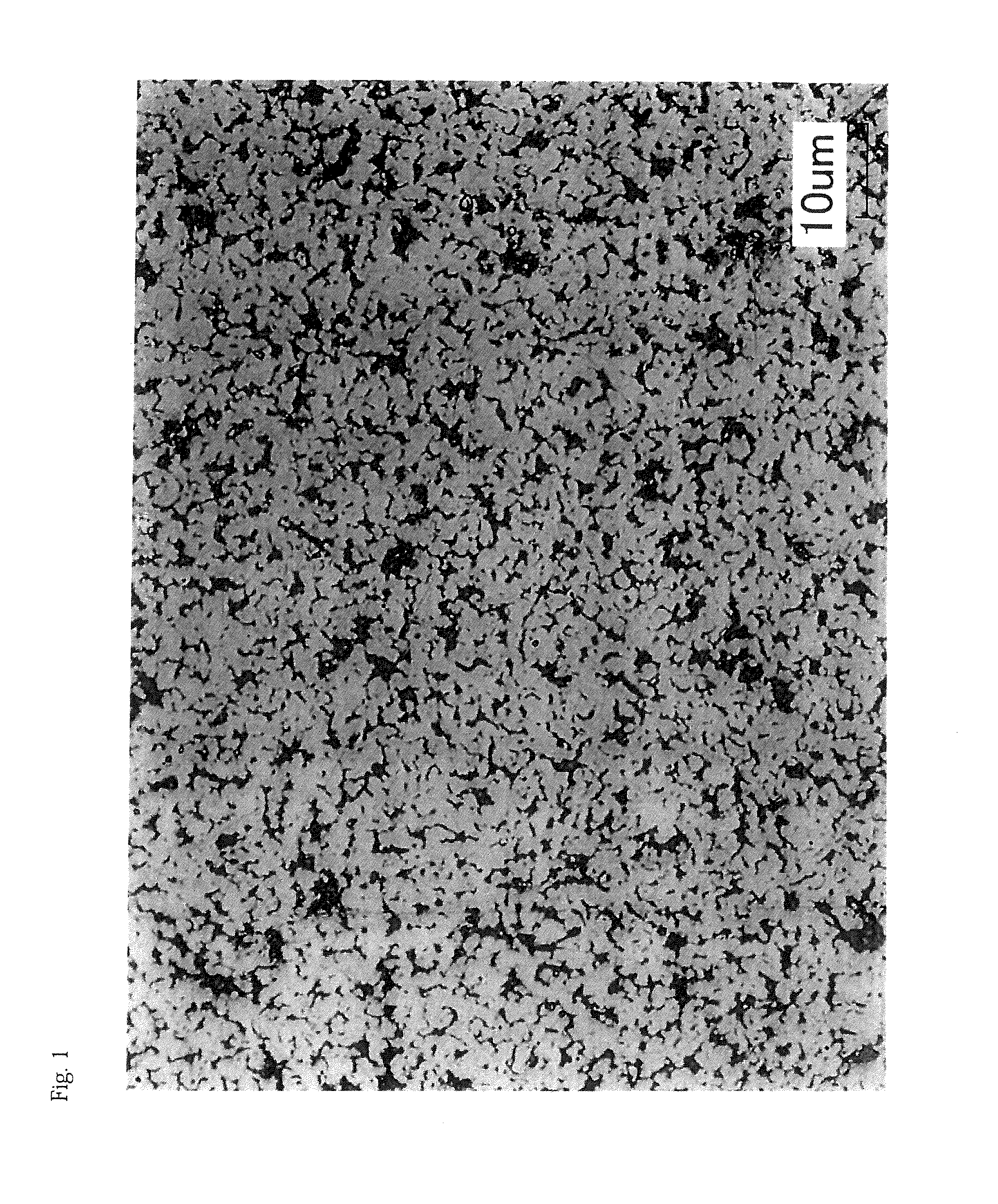Fe-Pt-C Based Sputtering Target
- Summary
- Abstract
- Description
- Claims
- Application Information
AI Technical Summary
Benefits of technology
Problems solved by technology
Method used
Image
Examples
example 1
[0048]An Fe powder having an average particle diameter of 3 μm, a Pt powder having an average particle diameter of 3 μm and a C powder having an average particle diameter of 1 μm were prepared as raw powders. For the C powder, a commercially available amorphous carbon was used. These powders were weighed to give a total weight of 2600 g and the following atomic ratio.
Atomic ratio: (Fe50—Pt5O60—C40
[0049]Next, the weighed powders were transferred and sealed in a 10 L ball mill pot along with zirconia balls as grinding media, and rotated for 4 hours for mixing and grinding. Then the mixed powder was removed from the ball mill to perform heat treatment.
[0050]The conditions of the heat treatment were as follows: Ar atmosphere (atmospheric pressure), the rate of temperature increase: 300° C. / hour, holding temperature: 900° C. and holding time: 2 hours. The powder was removed from the heat-treating furnace after naturally cooled, and transferred and sealed in a 10 L ball mill pot along wi...
example 2
[0061]An Fe powder having an average particle diameter of 3 μm, a Pt powder having an average particle diameter of 3 μm, a Cu powder having an average particle diameter of 3 μm and a C powder having an average particle diameter of 1 μm were prepared as raw powders. For the C powder, a commercially available amorphous carbon was used.
[0062]These powders were weighed to give a total weight of 2380 g and the following atomic ratio.
Atomic ratio: (Fe40—Pt45—Cu15)55—C45
[0063]Next, the weighed powders were transferred and sealed in a 10 L ball mill pot along with zirconia balls as grinding media, and rotated for 4 hours for mixing and grinding. Then the mixed powder was removed from the ball mill to perform heat treatment.
[0064]The conditions of the heat treatment were as follows: Ar atmosphere (atmospheric pressure), the rate of temperature increase: 300° C. / hour, holding temperature: 800° C. and holding time: 2 hours. The powder was removed from the heat treating furnace after naturally...
example 3
[0075]An Fe powder having an average particle diameter of 3 μm, a Pt powder having an average particle diameter of 3 μm, an Ag powder having an average particle diameter of 1 μm and a C powder having an average particle diameter of 1 μm were prepared as raw powders. For the C powder, a commercially available amorphous carbon was used.
[0076]These powders were weighed to give a total weight of 2200 g and the following atomic ratio.
Atomic ratio: (Fe42.5—Pt42.5—Ag15)60—C40
[0077]Next, the weighed powders were transferred and sealed in a 10 L ball mill pot along with zirconia balls as grinding media, and rotated for 4 hours for mixing and grinding. Then the mixed powder was removed from the ball mill to perform heat treatment.
[0078]The conditions of the heat treatment were as follows: Ar atmosphere (atmospheric pressure), the rate of temperature increase: 300° C. / hour, holding temperature: 850° C. and holding time: 2 hours. The powder was removed from the heat treating furnace after natu...
PUM
| Property | Measurement | Unit |
|---|---|---|
| Temperature | aaaaa | aaaaa |
| Temperature | aaaaa | aaaaa |
| Pressure | aaaaa | aaaaa |
Abstract
Description
Claims
Application Information
 Login to View More
Login to View More - R&D
- Intellectual Property
- Life Sciences
- Materials
- Tech Scout
- Unparalleled Data Quality
- Higher Quality Content
- 60% Fewer Hallucinations
Browse by: Latest US Patents, China's latest patents, Technical Efficacy Thesaurus, Application Domain, Technology Topic, Popular Technical Reports.
© 2025 PatSnap. All rights reserved.Legal|Privacy policy|Modern Slavery Act Transparency Statement|Sitemap|About US| Contact US: help@patsnap.com


